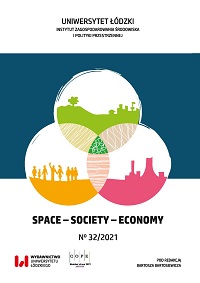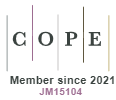Ocena homogeniczności regionów w Polsce z punktu widzenia struktury wieku ludności
DOI:
https://doi.org/10.18778/1733-3180.32.06Słowa kluczowe:
struktura wieku populacji, klasyfikacja, metoda Warda, region, demografiaAbstrakt
Miasta, zwłaszcza te pełniące funkcję stolicy województwa, stanowią istotny element każdego regionu, zarówno pod względem gospodarczym, społecznym, jak i demografia siła ich polaryzacyjnego oddziaływania często sięga poza administracyjne granice regionu. Celem opracowania jest ocena homogeniczności (lub dywergencji) województw z punktu widzenia struktury wieku populacji, a także ocena stopnia podobieństwa struktury wieku populacji zamieszkującej powiaty do tejże struktury mieszkańców stolic wojewódzkich. Analizy poprzedzone zostały charakterystyką województw Polski oraz ich stolic w latach 2002 i 2018 z punktu widzenia struktury wieku ludności, ze szczególnym uwzględnieniem procesu starzenia się populacji. Następnie dla danych z 2018 r., przy wykorzystaniu metody Warda, przeprowadzona została klasyfikacja powiatów leżących w granicach województw których stolicami są największe pod względem liczby mieszkańców miasta oraz województw Polski Wschodniej. Dokonano też oceny podobieństwa powiatów leżących na obszarze wymienionych województw do ich stolic pod względem struktury wieku ludności w 2018 r. Uzyskane rezultaty wykazały większą homogeniczność regionów Polski Wschodniej pod względem podobieństwa powiatów leżących w ich granicach do stolic poszczególnych województw z punktu widzenia struktury wieku ludności, niż regiony których stolicami są największe pod względem liczby ludności miasta.
Pobrania
Bibliografia
Abramowska-Kmon A., 2011, O nowych miarach zaawansowania procesu starzenia się ludności, „Studia Demograficzne”, 1(159): 3–22.
Google Scholar
Dębicki J., 2003, Lokalne bieguny wzrostu w Polsce (według budżetów gmin i przedsiębiorczości prywatnej), „Prace Komisji Geografii Przemysłu”, 5: 31–59.
Google Scholar
DOI: https://doi.org/10.24917/20801653.5.2
Grabiński T., Wydymus S., Zeliaś A. (red.), 1989, Metody taksonomii numerycznej w modelowaniu zjawisk społeczno-gospodarczych, PWN, Warszawa.
Google Scholar
Grzeszczak J., 1999, Bieguny wzrostu a formy przestrzeni spolaryzowanej, „Prace Geograficzne”, 173, IGIPZ PAN, Wydawnictwo Contunuo, Wrocław.
Google Scholar
GUS 2020, Klasyfikacja NUTS w Polsce, https://stat.gov.pl/statystyka-regionalna/jednostki-terytorialne/klasyfikacja-nuts/klasyfikacja-nuts-w-polsce/ (dostęp: 15.09.2020).
Google Scholar
Harasimowicz A., 2018, Suburbanizacja a rola obszarów otaczających miasto – ujęcie teoretyczne, „Studia Miejskie”, 29: 115–130.
Google Scholar
DOI: https://doi.org/10.25167/sm2017.029.08
Heffner K., 2016, Procesy suburbanizacji a polityka miejska w Polsce, [w:] Marszał T. (red.), Miasto – region – gospodarka w badaniach geograficznych. W stulecie urodzin Profesora Ludwika Straszewicza, Wydawnictwo Uniwersytetu Łódzkiego, Łódź.
Google Scholar
DOI: https://doi.org/10.18778/8088-005-4.05
Holzer J.Z., 2003, Demografia, PWE, Warszawa.
Google Scholar
Jałowiecki B., 2000, Społeczna przestrzeń metropolii, Warszawa.
Google Scholar
Janas K., Piech K., Trzepacz P., 2019, Współczesne i prognozowane przemiany ludnościowe polskich miast, [w:] Krzysztofik R. (red.), Przemiany demograficzne miast Polski. Wymiar krajowy, regionalny i lokalny, Instytut Rozwoju Miast i Regionów, Warszawa–Kraków: 23–40.
Google Scholar
Kałuża-Kopias D., 2015, Polscy emigranci w późnym wieku, „Acta Universitatis Lodziensis. Folia Oeconomica”, 4(315): 55–69.
Google Scholar
DOI: https://doi.org/10.18778/0208-6018.315.05
Kałuża-Kopias D., 2017, Skłonność do migracji najstarszych seniorów – mieszkańców wielkichmiast, „ Acta Universitas Lodzensis. Folia Oeconomica.”, 3(329): 147–165.
Google Scholar
DOI: https://doi.org/10.18778/0208-6018.329.10
Kantor-Pietraga I., Krzysztofik R., 2019, Mechanizm korzyści aglomeracji w rozwoju demograficznym miasta, [w:] Krzysztofik R. (red.), Przemiany demograficzne miast Polski. Wymiar krajowy, regionalny i lokalny, Instytut Rozwoju Miast i Regionów, Warszawa–Kraków: 169–182.
Google Scholar
Kolenda M., 2006, Taksonomia numeryczna. Klasyfikacja, porządkowanie i analiza obiektów wielocechowych, Wydawnictwo Akademii Ekonomicznej we Wrocławiu, Wrocław.
Google Scholar
Kotowska I.E., 1999, Drugie przejście demograficzne i jego uwarunkowania, [w]: Kotowska I. (red), Przemiany demograficzne w Polsce w latach 90. w świetle koncepcji drugiego przejścia demograficznego, „Monografie i opracowania”, 461, Oficyna Wydawnicza Szkoły Głównej Handlowej, Warszawa.
Google Scholar
Kowaleski J.T., 2008, Miasto jako przedmiot badań w demografii, [w]: Jałowiecki B. (red.), Miasto jako przedmiot badań naukowych w początkach XXI wieku, Wydawnictwo Naukowe Scholar, Warszawa.
Google Scholar
Kowaleski J.T., Majdzińska A., 2012, Miary i skale zaawansowania starości demograficznej, [w]: Rossa A. (red.), Wprowadzenie do gerontometrii, Wydawnictwo Uniwersytetu Łódzkiego, Łódź.
Google Scholar
DOI: https://doi.org/10.18778/7525-788-5.02
Kurek S., Lange M., 2013, Zmiany zachowań prokreacyjnych w Polsce w ujęciu przestrzennym, Wydawnictwo Naukowe Uniwersytetu Pedagogicznego, Kraków.
Google Scholar
Kurek S., Gałka J., Wójtowicz M., 2015, Wpływ procesów suburbanizacji na przemiany demograficzne krakowskiego obszaru metropolitalnego, „Studia Ekonomiczne. Zeszyty Naukowe Uniwersytetu Ekonomicznego w Katowicach”, 223: 206–222.
Google Scholar
Lesthaeghe R., 2010, The unfolding story of the second demographic transition, “Population and Development Review”, 36(2): 211–225, https://doi.org/10.1111/j.1728–4457.2010.00328.x
Google Scholar
DOI: https://doi.org/10.1111/j.1728-4457.2010.00328.x
Łagodziński W.W., 2012, Tworzenie statystycznego obrazu metropolitalnego ośrodka miejskiego na przykładzie metropolii warszawskiej, referat wygłoszony podczas konferencji naukowej pt. „Statystyczny obraz metropolii – stan obecny i perspektywy rozwoju” (Toruń, 15–16.11.2012), http://www.stat.gov.pl/cps/rde/xbcr/pts/Obraz_metropolii_warszawskiej.pdf (dostęp: 10.03.2020).
Google Scholar
Markowski T., Marszał T., 2006, Metropolie, obszary metropolitalne, metropolizacja. Problemy i pojęcia podstawowe, KPZK PAN, Warszawa.
Google Scholar
Młodak A., 2006, Analiza taksonomiczna w statystyce regionalnej, Difin, Warszawa.
Google Scholar
Okólski M., 2004a, Demografia. Podstawowe pojęcia, procesy i teorie w encyklopedycznym zarysie, Wydawnictwo Naukowe Scholar, Warszawa.
Google Scholar
Okólski M., 2004b, Demografia zmiany społecznej, Wydawnictwo Naukowe Scholar, Warszawa.
Google Scholar
Okólski M., Fihel A., 2012, Demografia. Współczesne zjawiska i teorie, Wydawnictwo Naukowe Scholar, Warszawa.
Google Scholar
Panek T., 2009, Statystyczne metody wielowymiarowej analizy porównawczej, SGH, Warszawa.
Google Scholar
Perroux F., 1978, Uwagi o pojęciu „biegun wzrostu”, [w:] Grzeszczak T., Teoria biegunów wzrostu, „Przegląd Zagranicznej Literatury Geograficznej”, 3/4: 26–40.
Google Scholar
Pytel S., 2017, Migracje emerytów w Polsce – czynniki, kierunki, konsekwencje, Wydawnictwo Uniwersytetu Śląskiego, Katowice.
Google Scholar
DOI: https://doi.org/10.18778/0208-6018.328.09
Rosset E., 1959, Proces starzenia się ludności. Studium demograficzne, Polskie Wydawnictwa Gospodarcze, Warszawa.
Google Scholar
Runge J., Kantor-Pietraga I., Krzysztofik R., Runge A., 2019, Chcę mieszkać w Polsce, ale czy w mieście?, [w:] Krzysztofik R. (red.), Przemiany demograficzne miast Polski. Wymiar krajowy, regionalny i lokalny, Instytut Rozwoju Miast i Regionów, Warszawa–Kraków: 129–144.
Google Scholar
Serwis Programu Polska Wschodnia, https://www.polskawschodnia.gov.pl/strony/o-programie/fe-dla-polski-wschodniej-2021–2027/zalozenia-nowego-programu/ (dostęp: 26.11.2021).
Google Scholar
Sokołowski A., Zając K., 1987, Rozwój demograficzny a rozwój gospodarczy, PWE, Warszawa.
Google Scholar
Strahl D., Obrębalski M., 2006, Identyfikacja regionalnej polaryzacji strukturalnej dla wybranych ośrodków i obszarów metropolitalnych w Polsce, [w]: Strahl D. (red.), Metody oceny rozwoju regionalnego, Wydawnictwo Akademii Ekonomicznej we Wrocławiu, Wrocław.
Google Scholar
Szmytkie R., 2013, W kwestii metropolii i obszarów metropolitalnych, „Przegląd Administracji Publicznej”, 2: 35–47.
Google Scholar
Szukalski P., 2017, Starzenie się ludności miast wojewódzkich – przeszłość, teraźniejszość, przyszłość, „Demografia i Gerontologia Społeczna – Biuletyn Informacyjny”, 12: 1–5, https://dspace.uni.lodz.pl/handle/11089/24279 (dostęp: 1.12.2021).
Google Scholar
Szukalski P., 2018, Rozwój demograficzny dawnych i obecnych stolic województw, „Demografia i Gerontologia Społeczna – Biuletyn Informacyjny”, 7: 1–6, https://dspace.uni.lodz.pl/handle/11089/25961 (dostęp: 1.12.2021).
Google Scholar
Szukalski P., 2019, Rozwój demograficzny wielkich miast w Polsce na przełomie XX i XXI wieku, „Demografia i Gerontologia Społeczna – Biuletyn Informacyjny”, 12: 1–6, https://dspace.uni.lodz.pl/handle/11089/32046 (dostęp: 1.12.2021).
Google Scholar
Van de Kaa D.J., 1987, Europe’s Second Demographic Transition, „Population Bulletin”, 42(1): 1–59.
Google Scholar
Van de Kaa D.J., 1997, Options and sequences: Europe’s demographic patterns, „Journal of Australian Population Association”, 14(1): 1–29.
Google Scholar
DOI: https://doi.org/10.1007/BF03029484
Van de Kaa D.J., 2002, The idea of a Second Demographic Transition in Industrialized Countries – paper presented at the Sixth Welfare Policy Seminar of the National Institute of Population and Social Security, Tokyo, Japan, 29 January 2002, http://www.ipss.go.jp/webj-ad/WebJournal.files/population/2003_4/Kaa.pdf (dostęp: 10.02.2021).
Google Scholar
Walenia A., 2010, Procesy metropolizacji a konkurencyjność regionów Polski Wschodniej, [w:] Sokołowski J., Sosnowski M., Żabiński A. (red.), Polityka ekonomiczna, Wydawnictwo Uniwersytetu Ekonomicznego we Wrocławiu, Wrocław.
Google Scholar
Ward J.H., 1963, Hierarchical grouping to optimize an objective function, „Journal of the American Statistical Association”, 58: 236–244.
Google Scholar
DOI: https://doi.org/10.1080/01621459.1963.10500845
GUGiK, http://www.gugik.gov.pl/pzgik/dane-bez-oplat/dane-z-panstwowego-rejestru-granic-i-powierzchni-jednostek-podzialow-terytorialnych-kraju-prg (dostęp: 20.02.2020)
Google Scholar
GUS, 2019, Rocznik Demograficzny 2019, Warszawa.
Google Scholar
GUS (BDL), Bank Danych Lokalnych, https://bdl.stat.gov.pl/BDL/start (dostęp: 20.02.2020).
Google Scholar
Opublikowane
Jak cytować
Numer
Dział
Licencja

Utwór dostępny jest na licencji Creative Commons Uznanie autorstwa – Użycie niekomercyjne – Bez utworów zależnych 4.0 Międzynarodowe.









